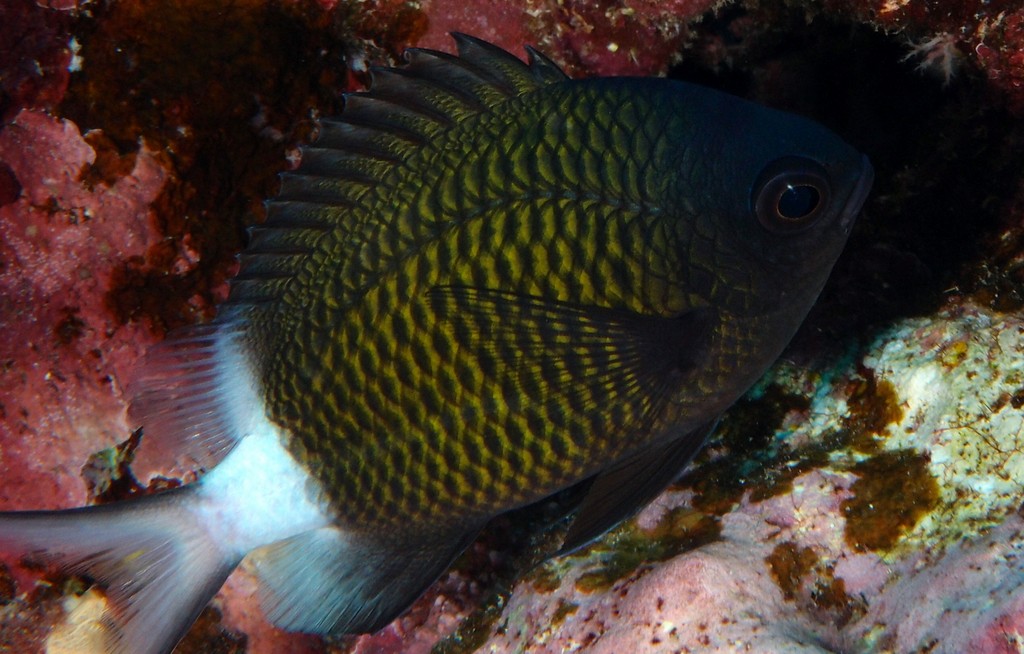CHROMIS CHRYSURA - (BLISS, 1883)
Actinopterygii (Gigaclass) > Actinopteri (Class) > Teleostei (Subclass) > Blenniiformes (Order) > Pomacentridae (Family) > Chrominae (Subfamily) > Chromis (Genus)
Chromis corpulent, Poisson de corail, Chromis à queue blanche, Débouetteur, Robust puller, Stout chromis, Stout-body chromis, Stoutbody puller, Amami suzumedai, アマミスズメダイ, 長棘光鰓魚, 短身光鰓雀鯛,
Synonymes
Chromis chrysurus (Bliss, 1883)
Chromis isharae (Schmidt, 1930)
Dascyllus isharae (Schmidt, 1930)
Heliastes chrysurus (Bliss, 1883)
Heliastes chysurus (Bliss, 1883)
Lepicephalochromis westalli (Whitley, 1964)
Siphonochromis lepidostethicus (Fowler, 1946)
--------------------------
Description
Dorsal spines (total): 13; Dorsal soft rays (total): 14-15; Anal spines: 2; Anal soft rays: 13-14; Pectoral rays: 18-19; Lateral-line scales: 17-19; Gill rakers: 29-33; Body depth: 1.6-1.8 in SL. Max. length: 14.0 cm SL. Depth range: 6 - 45 m.
Color
A deep-bodied olive-green, brown to greyish puller with a white caudal peduncle and tail, white posterior rays in the dorsal and anal fins, dark upper and lower caudal-fin rays, a pale crescent-shaped mark below the eye, and a dark vertical mark on each scale.
Etymology
Chromis: from Greek, chroemo = to neigh. A name dating to Aristotle, referring to a drum (Sciaenidae) and its ability to make noise; Later applied to this damselfish and subsequently expanded to embrace dottybacks, cichlids and wrasses (all perch-like fishes once thought to be related).
Chrysura: from Latin, chrysus = gold colour + from Latin, oura = tail. Referring to yellow caudal fin (in spirits, white in life) with a broad dark margin.
Original description: Heliastes chrysurus Bliss, 1883 - Type locality: Mauritius, Mascarenes, southwestern Indian Ocean.
Distribution
Indo-West Pacific: Mascarenes east to Fiji and Tonga, north to southern Japan, south to New South Wales (Australia) and New Caledonia.
Biology
Adults inhabit outer coral or rocky reefs. They usually form large aggregations in shallow waters e.g. in lagoons; Planktivore - groups feed on plankton well above the seafloor. Oviparous, distinct pairing during breeding. Eggs are demersal and adhere to the substrate. Males guard and aerate the eggs.
Last update: 19, September 2021
Chromis corpulent, Poisson de corail, Chromis à queue blanche, Débouetteur, Robust puller, Stout chromis, Stout-body chromis, Stoutbody puller, Amami suzumedai, アマミスズメダイ, 長棘光鰓魚, 短身光鰓雀鯛,
Synonymes
Chromis chrysurus (Bliss, 1883)
Chromis isharae (Schmidt, 1930)
Dascyllus isharae (Schmidt, 1930)
Heliastes chrysurus (Bliss, 1883)
Heliastes chysurus (Bliss, 1883)
Lepicephalochromis westalli (Whitley, 1964)
Siphonochromis lepidostethicus (Fowler, 1946)
--------------------------
Description
Dorsal spines (total): 13; Dorsal soft rays (total): 14-15; Anal spines: 2; Anal soft rays: 13-14; Pectoral rays: 18-19; Lateral-line scales: 17-19; Gill rakers: 29-33; Body depth: 1.6-1.8 in SL. Max. length: 14.0 cm SL. Depth range: 6 - 45 m.
Color
A deep-bodied olive-green, brown to greyish puller with a white caudal peduncle and tail, white posterior rays in the dorsal and anal fins, dark upper and lower caudal-fin rays, a pale crescent-shaped mark below the eye, and a dark vertical mark on each scale.
Etymology
Chromis: from Greek, chroemo = to neigh. A name dating to Aristotle, referring to a drum (Sciaenidae) and its ability to make noise; Later applied to this damselfish and subsequently expanded to embrace dottybacks, cichlids and wrasses (all perch-like fishes once thought to be related).
Chrysura: from Latin, chrysus = gold colour + from Latin, oura = tail. Referring to yellow caudal fin (in spirits, white in life) with a broad dark margin.
Original description: Heliastes chrysurus Bliss, 1883 - Type locality: Mauritius, Mascarenes, southwestern Indian Ocean.
Distribution
Indo-West Pacific: Mascarenes east to Fiji and Tonga, north to southern Japan, south to New South Wales (Australia) and New Caledonia.
Biology
Adults inhabit outer coral or rocky reefs. They usually form large aggregations in shallow waters e.g. in lagoons; Planktivore - groups feed on plankton well above the seafloor. Oviparous, distinct pairing during breeding. Eggs are demersal and adhere to the substrate. Males guard and aerate the eggs.
Last update: 19, September 2021
